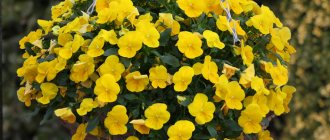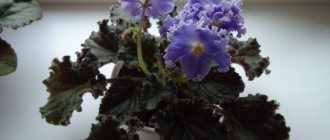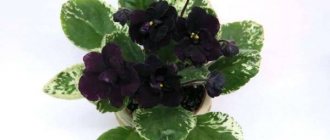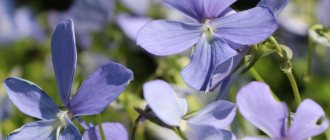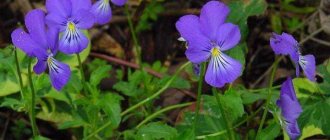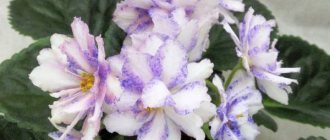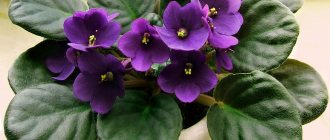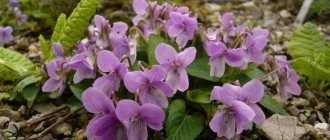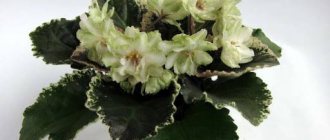Description
This perennial plant belongs to the genus Violet, family Violet-like. It can reach sizes (height) of up to 26 cm. The flowers have a pleasant aroma and grow in diameter from 2.5 to 5 cm. The petals are quite long, reminiscent of butterfly wings. It grows in small bushes, which, when planted close together, form a kind of carpet.
The violet owes its name to the process present on the back of the flower, similar to a horn or spur. Some modern hybrids of this species do not have such a distinctive horn.
It has been used in gardening as an ornamental plant since the late 18th century.
Horned violet is a creeping plant that, thanks to its branched rhizome, grows widely. 2-3 plants in the second year can completely cover an area of about 2 square meters. m. Flowers grow abundantly on the bushes. So on one viola you can count up to 60 buds and blossoming flowers.
The leaves of the plant are dark green, oval, with rounded teeth at the edges of some varieties. On long cuttings there are single flowers, in their middle there is a yellow or orange “eye”. There are many colors of the petals themselves, developed using the hybridization method. They can be: lilac, yellow, orange, purple, burgundy, etc. There are also single-color varieties of violets, which are most widely used in the design of large flower beds, as well as in landscape design. There are varieties with a combination of several shades of the same color, these are popular among amateur gardeners.
Another undeniable advantage of horned violets is their long flowering. It starts in May and ends by the end of September. In spring there is a peak of this process, the flowers are the largest and there are many of them, by autumn this process gradually subsides.
They feel good and enjoy strong flowering in one place for 5 years, then they need to be transplanted to another.
Photo report from the spring exhibition at the Moscow House of Violets. Part I
Hello, dear forum users and site guests. Currently, the Moscow House of Violets is hosting the exhibition “Spring Gift - 2015”, in which the Moscow Collectors group is taking part. I was able to visit this exhibition. They say that there is never too much beauty. But there was so much beauty at this exhibition! I was pleased with the abundance of neat, well-formed rosettes with lush bouquets, a variety of varieties for every taste. A collector from Vologda, Ivan Rachkov, brought a collection of his chimera violets to this exhibition. There were many interesting miniatures. And all the violets presented are one more beautiful than the other. I think that the judges at this exhibition had a difficult job - to choose the best. Here you can see the winners of the exhibition, what is called “first-hand”. Let's start watching with standards.
Picasso (Tremblay) - the first among variegated violets and the first violet of the “Best in Snow” exhibition:
And further:
RS-Dryad (sport) - a very beautiful rosette, but without polka dots:
I spent a long time choosing between RM-Lacemaker and RM-Royal lace. Both are very good:
I fell in love with the LE-Dandy variety at the winter exhibition. I struggled with myself for a long time. But when I saw Marina Karpova’s rosette, I couldn’t resist and bought a cutting.
Here Marina chooses a cutting for me:
Ma's Soap Bubbles - "Soap Bubbles" - flaunts an airy bouquet:
Everyone's favorite "Fairy":
LE-Two rosettes from different collectors. and both are good:
And this is another rosette of this type:
The new product LE-Surprise Winter was a great success at previous exhibitions.
And this is the sport from this variety, in my opinion. cute:
Chic blue ruffles at PC-Ophelia:
PT-Nightingale trill - a wonderful compact rosette and huge “singing” flowers:
LE-Macho - a chic, powerful rosette and a luxurious bouquet:
And another “Winter smiles”:
LE-Tristan, raised by Irina Leonidovna, was very harmonious:
LE-Southern Night in any version is very beautiful:
LE-Leto Red (chimera sport) won the “Best Folk Chimera” category. An interesting bouquet. All the rich and deep red color was concentrated in stripes in the center of the petals, and the edges of the petals were slightly discolored.
And this is “Red Summer” itself with monochromatic colors:
LE-Copper Horseman - a very unusual, spectacular flowering:
EC-Strasbourg stood modestly on the sidelines. It seemed to me. that this outlet was worthy of a place in the “first rows”. Compact, neat, dark green leaves and a bouquet of rich dark red flowers with slightly pointed petal tips and a variable white border looked very solemn.
Blue Dragon is always good. Unfortunately, the color is not reproduced accurately.
LE-Chateau Brion in two versions:
Another “greenback” Irish Glen:
And this yellow-flowered beauty is Le Oscar:
Look how fluffy “Snow in April” is:
And pink bells against the background of scalloped foliage:
And more white hats:
LE-Parnassus rose conquered! An ideal rosette, a beautiful bouquet on strong peduncles. Luxurious violet!
LE-Dreams Sultan has a rosette - a fairy tale! Such beautiful variegation! And goes well with delicate lilac-lavender flowers:
With this, let me finish the first part of the report from the exhibition. I hope that viewing the exhibition standard violets was interesting and not too tiring. See you in the second part of the report.
Horned violet: varieties
Currently, breeders are actively developing new hybrid varieties of violets. But when planting them, it is important to remember that they survive the winter much worse and need to be well covered for this period of time. And also some of them are biennial plants, not five-year olds. The most common varieties are the following.
| Variety | Description / Flowering period |
| Molly Sanderson | They have an unusual color: black or dark purple with a yellow spot in the center of the flower. The bushes are spreading, growing up to 15 cm in height. The leaves are green and shine in the sun. It has a fairly high resistance to frost, but it is still necessary to cover them for the winter. It is better to plant in shaded areas, where it will be much more comfortable than in the sun. Starts in April. |
| Rebecca | The height of the bushes reaches 15 cm. It is valued by flower growers for its long and massive flowering. It grows into a lush carpet. Looks good when planted near shrubs. The petals are light yellow in color, with purple strokes along the edges. In hot weather, the plant needs watering. From the beginning of June until the first frost. |
| Foxbrook Cream | The color of the flowers is snow-white. It is actively used to frame flower beds and sometimes borders. Grows in both partial shade and sun. It is not necessary to trim the green parts of the plant for the winter. From early May to September. |
| Boton Blue | Low bushes - no more than 10 cm. Flowers are pale blue. Grows best in light, moist soil. From March until the first frost. |
| Viola Columbine | The plant is creeping, reaches 20 cm. The leaves are oblong, green, with large teeth along the edge. The flowers are variegated in white, blue and lilac shades. They prefer loose, fertile soil. If the winter turns out to be a small amount of snow, it is recommended to cover the plants, for example, with spruce branches. From May to October. |
| Sorbet Wy-Ti-Ti | The unusualness of this variety lies in the change in shades in different periods. At first they are colored blue, then blue appears, and at the end of flowering they become snow-white. |
| White perfection | The flowers are white and the center is yellow. They are resistant to frost. Used in landscape design as a ground cover plant, planted under trees. |
This is just a small list of violet varieties. There are a great many of them.
Varieties of Pugacheva
- Foreign selection
- Alen-... - CT-...
- LE-... (Lebetskaya variety)
- LEKO-... - NK-...
- PT-… (Pugacheva variety)
- RM-… (Skornyakova variety)
- RS-… (Repkina varieties)
- Fairy – YAN-Dressy
- Miniatures and semi-miniatures
- Streptocarpus
For fans of domestic selection, the catalog includes beautiful and very interesting varieties from the most popular breeders of Russia and Ukraine.
The price is indicated in rubles per plant leaf. The letter “L” indicates varieties that will be sold in the summer after mandatory prior approval (they will be grown only by summer).
| 468 | PT-Anna Boleyn (Pugacheva) | Large (up to 7cm) double white wavy flowers with a pink border and a rare blue fantasy, neat rosette. |
| 469 | PT-Astrid (Pugacheva) | Large, simple and semi-double, dark blue flowers decorated with pink fantasy in the form of large strokes and stripes. Along the edge of the flower there is a white and green border. Good peduncles, long flowering. A rosette of dark green leaves. |
| 472 | PT-Victory Suite (Pugacheva) | Huge semi-double and double beautiful blue flowers with a wavy purple border and a rare fantasy pink. Good peduncles, abundant flowering. A rosette of dark green leaves. |
| 473 | PT-Vilena (Pugacheva) | |
| 474 | PT-Grenille (Pugacheva) | |
| 476 | PT-Julia (Pugacheva) | Huge double flowers of a beautiful pink color with a wavy edge and a raspberry-lilac spray border. The flowers are decorated with rare blue fantasy in the form of specks and strokes. Good peduncles, abundant flowering. Green leaves. |
| 477 | PT-Blackberry Liqueur (Pugacheva) | |
| 478 | PT-Elizaveta (Pugacheva) | Large semi-double and double very beautiful white flowers with dark pink-coral markings. Lush cap flowering. Rosette of green leaves. |
| 481 | PT-Star Veil (Pugacheva) | |
| 482 | PT-Indian Dance (Pugacheva) | |
| 485 | PT-Katerina (Pugacheva) | Large, very beautiful double and densely double raspberry-fuchsia flowers with a white wavy-corrugated border. Abundant flowering, rosette of green leaves. |
| 486 | PT-Claret (Pugacheva) | |
| 487 | PT-Colombiana (Pugacheva) | |
| 488 | PT-Royal Spinel (Pugacheva) | |
| 490 | PT-Love Romance (Pugacheva) | Amazing large disc flowers, white with a beautiful clear venous crimson pattern, with a corrugated lightened edge. Wavy variegated rosette. Elegant and elegant! |
| 493 | PT-Maldives Reef (Pugacheva) | Very large, double, wavy-crimped, very beautiful voluminous flowers with ultramarine backlighting in the center. In cool growing conditions, a light green border appears. A good rosette of green leaves, strong peduncles, flowering in a cap. |
| 494 | PT-Heavenly Tent (Pugacheva) | Very large single and semi-double blue flowers with a white center. In cool conditions, a white border appears. A rosette of medium green leaves, abundant and long flowering. |
| 503 | PT-Motley Bird (Pugacheva) | |
| 505 | PT-Princess Jasmine (Pugacheva) | Large light pink flowers with a wide crimson ruffled ruffle. Wavy dark leaves. |
| 505 | PT-Princess Jasmine luxury (Pugacheva) | |
| 519 | PT-Lilac Dreams (Pugacheva) | |
| 520 | PT-Solomon Islands (Pugacheva) | |
| 527 | PT-Crystal Lady (Pugacheva) | Large wavy graceful pink flowers with a white center, a white border and a raspberry-lilac spray border. Neat rosette, good peduncles, flowering with a cap. Rosette of green leaves. |
| 529 | PT-Charlize (Pugacheva) | Very large, semi-double and double beautiful pink flowers with a ruffled lilac border of spraying. In cool conditions, the border becomes very thick, acquiring a brownish tint, and does not allow the flowers to fully open, forming pink buds. A neat rosette of dark green leaves. |
- Foreign selection
- Alen-... - CT-...
- LE-... (Lebetskaya variety)
- LEKO-... - NK-...
- PT-… (Pugacheva variety)
- RM-… (Skornyakova variety)
- RS-… (Repkina varieties)
- Fairy – YAN-Dressy
- Miniatures and semi-miniatures
- Streptocarpus
Features of cultivation and care
Horned violet is a perennial; hybrid varieties can be biennial or annual (if planted as seedlings in open soil). This plant is unpretentious to its growing conditions, but if you take into account some of its preferences and properly care for it, it will bloom better and delight the gardener.
Priming
It grows in almost any soil, but feels most comfortable in loose, light, fertile soil with drainage and a pH of 6.8-7.2. It grows and blooms profusely. It is important to mulch the soil. For this purpose, use: stones, drainage granules, gravel, wood chips and moss. Thanks to this, moisture is retained in the soil, weeds grow less and nutrients are washed out of the soil.
Landing location
It grows best in partial shade, near its taller counterparts, which will protect the violet from the midday sun. You shouldn’t plant it completely in the shade: the stem will begin to stretch, and the flowers will shrink in size and turn pale. In addition, there it is attacked by slugs and snails, which will not add beauty to the plant.
Watering
It should be moderate, it is produced as the soil dries. In hot weather, water more often. If the gardener is temporarily absent and cannot regularly water the violet, it will survive this without dying, but the flowering will become less intense with smaller buds.
With regular spraying (morning and evening) it grows better.
Top dressing
It is held in spring and late August. Mineral and organic fertilizers in weaker concentrations are best suited. It is worth remembering that manure is strictly prohibited. Since it has an extremely aggressive effect on the root system of the flower, damaging it.
Pruning and maintaining a decorative appearance
Sometimes the plant begins to stretch greatly in length, which makes its appearance untidy. In this case, they are trimmed, giving a compact and more well-groomed appearance. If there is no purpose for obtaining seeds, it is better to remove wilted inflorescences. This way the plant will not waste energy on their ripening and will bloom more abundantly and longer. This is also a method of preventing unwanted self-seeding.
Wintering
In general, violet is quite frost-resistant and can withstand temperatures down to -23 ℃. But it is worth remembering that hybrids are more sensitive to cold and should be covered with peat, fallen leaves or spruce branches. Also, newly planted young flowers are also covered for the cold season.
Rejuvenation of plantings
Once every few years (3-5) it is worth carrying out the procedure for rejuvenating plants. When you do this, you can easily notice: the flowers become smaller and there are fewer of them. To do this, dig up the roots and divide them into several parts and transplant them to a new location.
Domestic selection. Varieties of Pugacheva
- Foreign selection
- Domestic selection
- Miniatures and semi-miniatures
- Streptocarpus
- AB-Autumn Forest - KZ-Walk in the Sun
- LE-... (Lebetskaya variety)
- LiK-White Angel - NiL-Shamakha Queen
- PT-… (Pugacheva variety)
- RM-… (Skornyakova variety)
- RS-… (Repkina varieties)
- Holy Naivety - YAN-Dressy
For fans of domestic selection, the catalog includes beautiful and very interesting varieties from the most popular breeders of Russia and Ukraine.
The following symbols are used in the catalog:
- N – new selections from 2013 – 2014;
- Nk – new items in this catalogue;
- L – varieties that will be sold in the summer after mandatory prior approval (will be grown only by summer);
| 201 | PT-Adelina (Pugacheva) | Very large, double, airy flowers of light pink, almost white color along the edge are decorated with a soft lilac border of spraying. Abundant flowering. Medium green leaves. | 80 |
| 202 | PT-Angel (Pugacheva) | Large, double, wavy, white flowers with a slight pink blush, intensifying in the center of the flower. A neat rosette of green leaves. | 80 |
| 203 | PT-Anzhelika (Pugacheva) | Large double pink flowers with a ruffled two-color border: crimson dusting and white edge. The flower has a rare blue speck. Abundant flowering. Simple green leaves. Beautiful! | 80 |
| 204 N | PT-Vanessa (Pugacheva) | Very large, simple and semi-double lilac-muchsin stars with a white center and a lightened border along the wavy petals. Lush cap flowering. Medium green leaves. | 100 |
| 205 N | PT-Spring Palette (Pugacheva) | Large semi-double wavy flowers of light pink color with a raspberry-lilac border and in places a green ruffle, which appears in cool growing conditions. A rosette of medium green leaves. | 100 |
| 206 N | PT-Virginia (Pugacheva) | Very large, semi-double, slightly wavy flowers, beautiful pink-peach color with a white center and a white border along the edge of the petals. Good peduncles, abundant flowering cap. A neat rosette of medium green leaves. | 100 |
| 207 N | PT-Dina (Pugacheva) | Large, single and semi-double white flowers with soft pink prints and rare lilac fantasy on the petals. A neat rosette of green leaves. | 150 |
| 208 N | PT-Lady Hamilton (Pugacheva) | Huge, double and semi-double light pink flowers. The edges are decorated with a light lilac-raspberry border of spraying and rare strokes of the same color along the petals. Abundant flowering, medium green leaves. | 150 L |
| 209 N | PT-Summer Mood (Pugacheva) | Large, simple pink-peach flowers with white centers and wavy petal edges. Green leaves, strong peduncles. Abundant cap flowering. | 150 |
| 210 | PT-Louise (Pugacheva) | Large, semi-double pink flowers with a bright blue fantasy of dots, streaks and rivulets and a white wavy edge. A rosette of medium green leaves. | 80 |
| 211 N | PT-Lucretia (Pugacheva) | Very large, double, wavy flowers of a beautiful pink color with a white border and a white center. In cool conditions, a green border appears. Good peduncles, abundant and long flowering. A rosette of medium green leaves. | 150 |
| 212 N | PT-Heavenly Tent (Pugacheva) | Very large single and semi-double blue flowers with a white center. In cool conditions, a white border appears. A rosette of medium green leaves, abundant and long flowering. | 100 |
| 213 | PT-Night Moth (Pugacheva) | Very large, densely double dark purple flowers with a fringed thin white edge. A very beautiful flower shape - the flower looks like a carnation. Abundant flowering. Dark green, almost black foliage. | 80 |
| 214 N | PT-Olivia (Pugacheva) | Huge, single and semi-double, slightly fringed, white stars with soft pink prints and fantasy blue. A rosette of medium green leaves. | 150 |
| 215 | PT-First Lady (Pugacheva) | Sports from PT-Nonna. Very large single and semi-double light pink, almost white flowers with a deep pink eye and a border along the wavy edge of the petals. Powerful flower stalks. Lightly quilted green foliage. Super-abundant, scattered flowering of large, bright flowers made this variety a favorite of the December 2012 exhibition at the Violet House. | 80 |
| 216 | PT-First Date (Pugacheva) | A huge cap of large wavy white pansies with delicate pink prints on the lower petals. Compact rosette of green leaves. The flowering is so abundant that the leaves are not visible. | 80 |
| 217 N | PT-Beautiful Signorina (Pugacheva) | Very large, simple and semi-double wavy light pink, almost white, stars with a lilac border coated, changing from light to dark color. Standard rosette of dark green leaves. More spectacular and long-lasting flowering in natural light. | 100 |
| 218 | PT-Painted Veil (Pugacheva) | Large semi-double and double flowers of pink-coral color with abundant blue fantasy in the form of dots and stripes. Friendly flowering with a cap. Standard rosette of dark leaves. | 80 |
| 220 N | PT-Pink Frost (Pugacheva) | Large single and semi-double wavy light pink flowers with a white center. In cool conditions, the edges of the petals are decorated with a dark pink mesh and a white edge. The leaves are slightly wavy and lumpy; against their background the flowers look very delicate. Neat outlet. | 150 |
| 221 N | PT-Rufina (Pugacheva) | Large single and semi-double wavy pink-coral flowers with fantasy blue streaks and stripes. Green leaves, neat rosette, good peduncles. | 100 |
| 222 N | PT-Wedding Journey (Pugacheva) | Large single and semi-double white wavy flowers with soft pink prints and blue fantasy in the form of dots and small strokes. Medium green leaves, good peduncles, abundant cap flowering. | 150 |
| 223 N | PT-Nightingale Trill (Pugacheva) | Large stars of a beautiful pink color with a lilac border, sprayed along wavy petals and dark blue fantasy. Abundant flowering. A neat rosette of medium green leaves. | 150 |
| 226 | PT-Elenika (Pugacheva) | Large semi-double snow-white expressive flowers with a ruffled light green border and a light pink blush in the center. Very delicate bouquet and long flowering. A neat rosette of green leaves. | 80 |
| 227 N | PT-Yuliana (Pugacheva) | Simple, wavy stars of pink color with a lilac border of sputtering spreading across the flower and dark blue fantasy along the petals. Cap flowering, medium green leaves. | 150 |
| 228 | PT-Junona (Pugacheva) | Large light pink single and semi-double flowers. The edges of the petals are decorated with a dark pink mesh and a light green ruffle. Abundant flowering. Dark green leaves. | 80 |
| 229 N | PT-Yanina (Pugacheva) | Huge, semi-double and double light pink almost white flowers with a thin pink-crimson spray border. As a rule, the border appears from the second flowering and in cool conditions. | 100 |
| 230 N | PT-Yaroslav (Pugacheva) | Huge semi-double white flowers with blue prints and ruffled edges, abundant bloom. Standard rosette of green leaves. | 100 |
- RM-… (Skornyakova variety)
- RS-… (Repkina varieties)
- Holy Naivety - YAN-Dressy
Reproduction
Horned violet is propagated in several ways.
Horned violet from seeds
It can also be grown from seeds. This is done in two ways: directly sown in the soil or with pre-prepared seedlings.
Foxbrook Cream
Sowing seeds for seedlings
Seeds are planted from February to April. It is important to take into account that the earlier you plant them, the faster the plant will bloom. The period from sowing to the appearance of flowers is 10-13 weeks.
Pre-prepare a nutritious mixture of soil, bake it in the oven to disinfect it from infections and fungi, and pour it with Fundazol solution.
It is necessary to make furrows at a distance of 1.5-2 cm from each other, place the seeds in them, sprinkle the soil on top and spray with water from a spray bottle. It is important to check the germination capacity of a particular violet variety before sowing. It can vary from 60% to 95%.
Then the container with the sown seeds is covered with plastic wrap and watered periodically; the soil should not be allowed to dry out completely. The most suitable temperature for maximum germination is +12…+18 ℃. When the first shoots appear (after about 3-5 weeks), the container is moved to warmer conditions (+18…+22 ℃). It is necessary to remove the film for some time for ventilation. Its duration is gradually increased as the seedlings grow.
When 2-3 leaves appear on the plant, it is important to pick, planting them at intervals of 5-6 cm from each other.
It can be planted in open ground in May, but be sure to water regularly and loosen the soil. The first feeding is carried out after 14 days; mineral fertilizers are better suited.
Sowing seeds in open ground
Can be planted directly into the soil from May 10 to September 10. For this method, self-collected seeds are better suited, but you can also use purchased ones, then you need to take into account their germination.
Before planting, it is important to loosen the soil and make furrows in which the seeds are placed, covered with soil on top and watered.
Next year in the spring, seedlings will appear, which are important to protect from direct sunlight. If the sprouts are located too often, they need to be replanted. In August, the plants are transplanted to a permanent location. If flower ovaries appear, they are removed so that the nutritional juices are not consumed, and the violet survives the winter in a stronger state.
Next spring the plant will delight the gardener with its beautiful blooms.
Vegetative propagation of violets
It is divided into several subspecies.
Dividing the bush
The most suitable period is from early spring to mid-summer.
If you do it during this period, the violet will have time to develop a root system and by the fall it will be strong enough to survive the winter; if you divide later, there is a high probability of the plant dying.
The method is carried out in the following way: the bush is dug up, fragments with roots are separated from it. The separated parts are buried with soil in a shaded place, protected from strong winds, into moist soil. It is important not to let the soil dry out. It usually takes 2-3 weeks for the plant to take root. Next spring they can be transplanted to their intended place.
Reproduction by taps
One of the easiest methods of reproduction. It is necessary to select several long shoots, bend them, press them to the ground in several places with plastic or iron staples (you can use hairpins), sprinkle them, cover the places where the attachment is fixed with earth and water regularly. After about 1 month, roots will form on the stems buried in soil and should be separated from the general plant.
Cuttings
It is held from the beginning of June to the end of July. The shoots are cut into cuttings 5 cm long with 2-3 nodes and 3-4 leaves on each. They are stuck into a container with moist soil prepared in advance to a depth of approximately 1-1.5 cm at an acute angle. Cover the container with film and place it in a warm place protected from bright sunlight. Once a day, the polyethylene is removed for ventilation. After about 1 month, the cuttings begin to grow, which indicates their rooting. Now they can be transplanted into open ground in the shade. They are moved to a permanent place next spring.
Problems during cultivation
Violet, like many plants, is susceptible to various diseases and pest attacks. The table below shows the most common ones.
| Disease/pest | Defeat | Treatment |
| Powdery mildew | Black dots and cobwebs appear on the stems, leaves and buds. | It is necessary to spray the plant with an antifungal agent. |
| spotting | The disease begins on the leaves, then the stem dries out. It can also attack seeds. | The bed should be dug up and treated with chemical disinfectants. |
| Blackleg | The stem becomes thinner and darker. | Plants need to be thinned out, the soil loosened and treated with anti-fungal agents. |
| Gray rot | A fluffy gray coating appears on the flowers, then the plant begins to rot. | The bushes need to be thinned out, fertilized, and treated for fungal diseases. |
| Caterpillars | All parts of the plant are affected, mainly from May to June. | Spray with tobacco infusion and Chlorophos as soon as the first pests are noticed. |
Horned violet is not only a beautiful and unpretentious flower, but it is also successfully used in cooking. Fragrant flowers give salads, desserts, and yoghurts an exquisite, unusual taste and beautiful appearance. They are candied, frozen in ice cubes, and used to decorate various treats.
